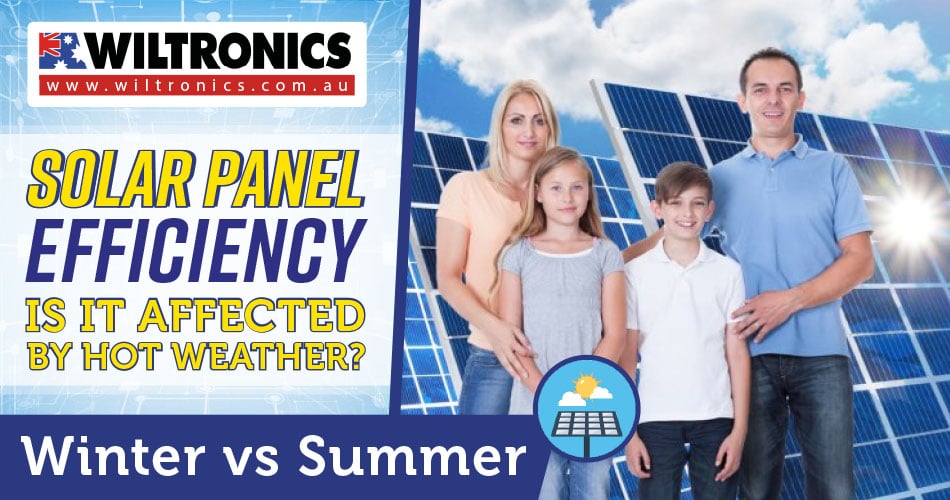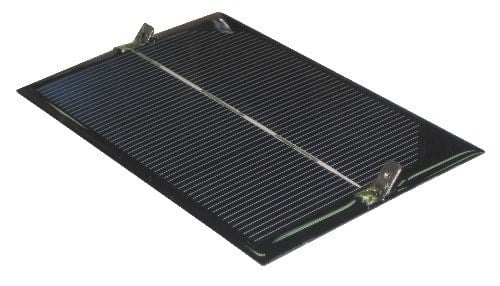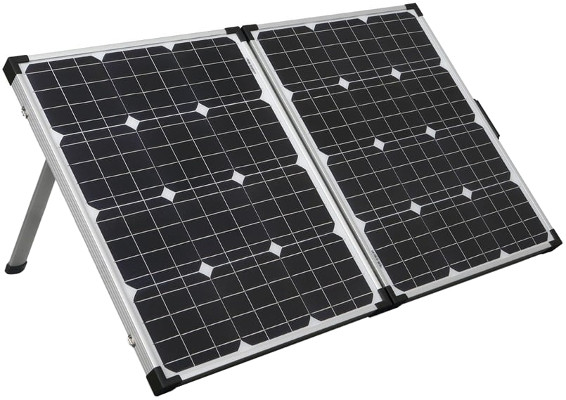Solar Panel Efficiency: Is it Affected by Hot Weather?
April 16, 2021

Solar panels capture the sun’s energy and turn it into electricity for homes or businesses. They do well on a clear day; the more sunlight, the more energy a solar panel can produce. But even though they work directly with the sun, the question is: does hot summer weather affect solar panel efficiency?
To understand the real relationship between heat—the weather, in general—and solar panels, then keep on reading.
Solar Panel Efficiency: How Do They Work?
Sunlight plays a significant role in solar production—and this is where solar panels take advantage of it.
As tiny packets of energy from the sun, known as photons, hit a solar cell, they knock electrons loose from their atoms. And when electrons zip through the circuit within the solar panel, the movement produces an electric current or electricity.
The Effect of Temperature on Solar Panel Efficiency
It is true that sunny weather can impact the amount of electricity solar panels can produce, but not exactly in the way you might think or expect.
Ideal weather conditions for producing solar energy include a clear sunny day, of course. However, like most electronics, solar panels tend to be more efficient in cold weather, allowing the panel to generate more electricity.
The laws of thermodynamics explain that with increased heat comes decreased power output, and this applies to solar panels. Thus, as the temperature rises, the panel renders less voltage and output and produces less electricity.
During the warmer months, reaching 32 degrees Celsius or higher, a solar panel may run about 10 to 25% less efficient. But how can you know what kind of output losses your panels are experiencing?
Temperature Coefficient
Manufacturers rate the susceptibility of their products to temperature in the form of temperature efficiency, which varies from model to model. This loss output is expressed as a percentage per degree Celcius, and the standard practice to test solar panels for power output is at 25 °C (77 °F).
If a panel is rated with a temperature coefficient of -.50% per °C, the panel’s output power will decrease by half a per cent for every degree the temperature rises above 25 °C/77 °F. Helio Energy Solutions has provided a precise example:
If your solar panel has an efficiency rating of 17% and a temperature coefficient of -0.45, the overall efficiency will decrease by 0.45% for every degree above 25 °C. And if the surface temperature of your roof increases to 30 – 35 °C, the efficiency falls to 16.3% – 16.7%.
How Hot Can Solar Panels Get?
When solar cells generate at maximum efficiency, a solar panel’s temperature usually ranges from 15 °C to 35 °C. But keep in mind that solar panels can also get as hot as 65°C (149 °F) at which point the solar cells will lose their efficiency, commonly known as energy output loss.
Instances like these usually occur when the panels are installed too close to the roof, affecting the typical heat of the solar panel system.
Reducing the Heat on Solar Panels
Energy output loss takes place due to high temperatures and unsuitable roof panel installation. But there are a few ways you can reduce the negative effects of extreme heat.
- When installing solar panels, make sure to set the panels a few inches above the roof to let air flow in, cooling the panels down.
- Opt for solar panels with light-coloured materials, as this type of material helps in reducing heat absorption.
- If you have inverters or combiners, place them into the shaded area behind the array.
Solar Panel Efficiency: Winter vs Summer
Another thing to keep in mind is when the temperature coefficient is lower than 25 °C, you do not have to worry. This only means that your panels have a positive temperature coefficient and optimal energy production.
This kind of efficiency in cold weather also helps offset losses that occur during the summer months, especially for homeowners living in regions with distinct summer and winter cycles. As per solar experts, solar panels may be more efficient in cold weather but that does not mean they can produce more electricity than in warm conditions.
Clear, sunny weather often occurs in the summer months. Meaning, your solar panel may be less effective in warmer months, still, they will likely produce more electricity. Note: In terms of the drop- or rise in temperature, this phenomenon depends on the region you live in.
In conclusion, the duration of access to sunlight is greater in the summertime, but operating temperature in the cold, winter months is ideal, too!
Types of Solar Panels and Common Types of Solar Cells
Solar energy begins with the sun, and the direct source can be collected by two different methods: solar thermal and solar photovoltaic (also known as solar PV) systems.
Solar thermal uses sunlight to heat a fluid—water, for instance—through a heat exchanger to convert heat from the sun into electricity. On the other hand, solar PV is based on the photovoltaic effect, relying on the photons to generate usable energy.
The most common and special types of solar panel cells:
- Crystalline silicon cells – Can reach over 25% level of efficiency
- Monocrystalline cells – 15% to 20% level of efficiency
- Polycrystalline cells – 13% to 16% level of efficiency
- Thin-film solar cells – 7% to 13% level of efficiency
Understanding these will help you assess which is the suitable type of solar panel for your household or business needs.
Wiltronics Solar Panels and Solar Cells

Solar Cells
Solar cells are part of a solar panel system that absorbs sunlight energy then convert it into electricity. They are bundled together to form larger units, also known as solar modules.
Here at Wiltronics, we offer a great range of Solar Cells—0.5, 1.5 & 2.0 Volt Modules—ideal for experimenting and powering models. The cells can easily be connected together in series for increased voltage or parallel for increased current.

Solar Panels Monocrystalline
The most popular type of solar panel, Monocrystalline, as the name suggests, features monocrystalline solar cells. This type of solar cell typically renders a high efficiency and power capacity.
If you are looking for this kind of solar panel, you might also want to check out our great selection of monocrystalline solar panels, designed with robust construction and performance to suit harsh Australian conditions.
We also have solar cables that can be easily connected to your solar controller or other solar hardware!
CONCLUSION
When talking about renewable energy sources and reduced energy consumption, solar panels are a key component. However, owning one can also be challenging, especially when the weather is not cooperating.
We want our solar panel system, whether it is for home or business use, to be worthwhile. We may have no control over the weather, but learning the solar panels efficiency is surely a great way for us to understand how solar panels work, how the weather affects the system, and how we can try to can improve the efficiency regardless.
© Electrotech Brands Pty Ltd 2021


Write a Comment
You must be logged in to post a comment.